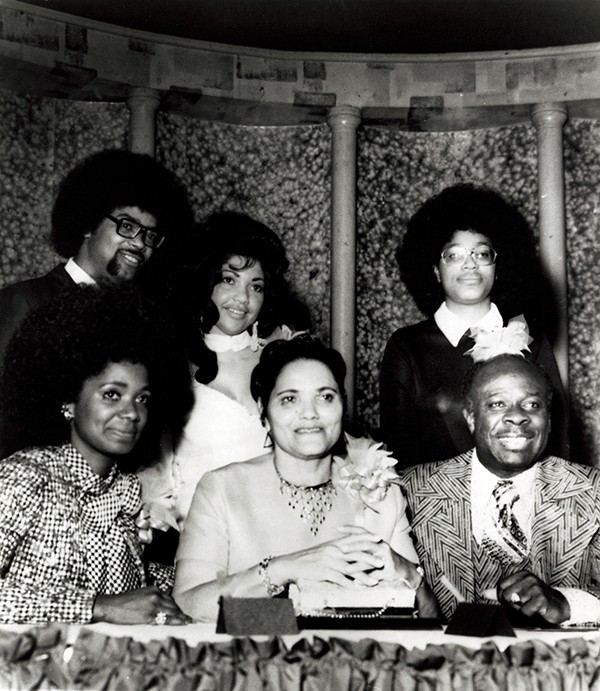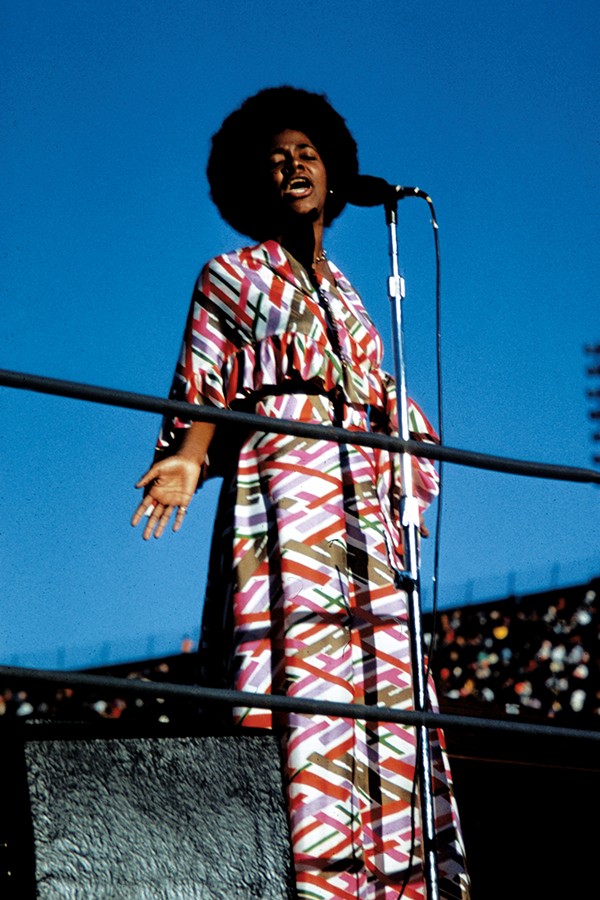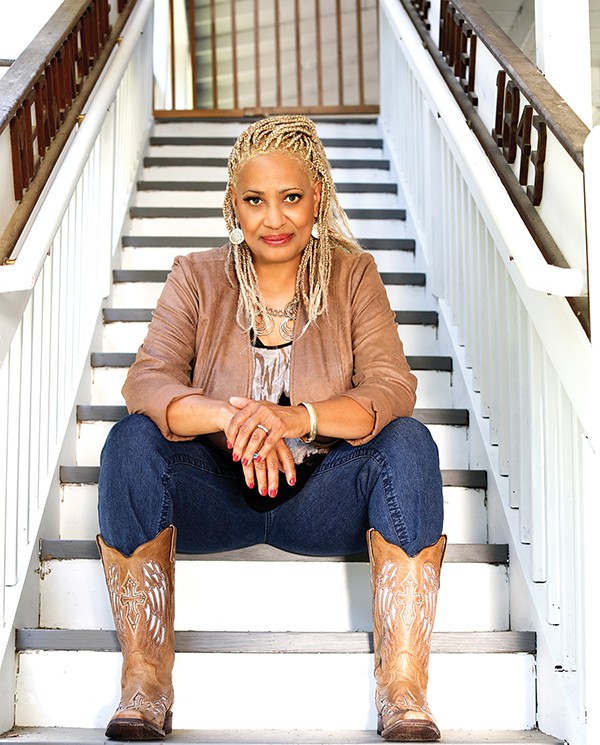In February, the Memphis Housing Authority took steps to remove the last dwellers from the city’s oldest public housing project, Foote Homes. Though many had left already, and though carcinogens stained the surrounding soil, some longtime residents were reluctant to go. Perhaps they still had vivid memories of a time when Foote Homes was at the center of a thriving neighborhood culture in South Memphis.
Some may have even known the place soon after it was built in 1941, when a young couple, Rufus and Lorene Thomas, moved in to start a family with their young son, Marvell. When daughter Carla was born a year later, they had little inkling that the Thomas family was just beginning, or that the father, son, daughter, and daughter-to-come would one day become stars on a global scale.
Rufus was a natural showman, having proven himself on the road with the Rabbit Foot Minstrels and the Royal American troupe, tap dancing, scat singing, and learning how to work a crowd. Perhaps it seemed he was leaving that life behind for good when he and Lorene settled at Foote Homes, but the call of the stage still rang in his ears.
Before long, he was back in touch with his old history teacher from Booker T. Washington High School, Nat D. Williams, a learned writer and entertainer — and a pillar of the community. Williams had been hosting a popular Amateur Show on Beale Street, and when he left, Rufus stepped in to replace him.
He would end up staying for over a decade, helping to launch the careers of B.B. King, Bobby “Blue” Bland, and local jazz stalwart Herman Green, among others. From there he would become a renowned deejay and recording artist, of course, but this track record can obscure the fact that he was also, first and foremost, a family man.
 Courtesy of Stax Museum of American Soul Music
Courtesy of Stax Museum of American Soul Music
Back: Mr. & Mrs. Marvell Thomas, Vaneese Thomas; Front: Carla, Lorene, and Rufus Thomas
To learn a bit more about the spirit of the Thomas family, which would ultimately nurture the talents of siblings Marvell, Carla, and Vaneese, I made my way to that hub of African-American culture in South Memphis, the Four Way Grill. Established in 1946, just a few blocks from the Capitol Theater, the eatery fed the Thomas kids and thousands of other Memphians for generations. When the Capitol was sold and became Satellite, and then Stax Records, the Four Way was a natural hang-out for performers as they dreamed of stardom. Community leaders of all kinds flocked there, and many of their photographs grace the walls. It’s the embodiment of the community of South Memphis and a reminder that to raise families full of potential, it may not take a village. Sometimes the neighborhood will do.
When Carla and Vaneese join me, I have to pinch myself. “Gee whiz, it’s Christmas!” I think. Of course, as soon as we sit down, talk gravitates to their legendary father who, even 16 years after his death, somehow still commands the room.
Vaneese, the “youngster” of the family, wants to emphasize the musicianship of her father. “If you ever see album credits listing so and so as the arranger of a Rufus Thomas session, don’t believe it. Daddy was always right there, going to each musician, telling them their parts.” She and Carla speak a little wistfully of their parents, and of their brother Marvell, who passed away earlier this year.
And yet it’s like they’re all there with us, as Carla relives her childhood days when Rufus first began working at “The Mother Station of Negroes,” WDIA. It was the first station in the nation to feature African-American deejays, and, as with the Amateur Hour on Beale, the road there was paved by Nat D. Williams, who helped Rufus step into B.B. King’s on-air slot after King’s music took him on the road.
Despite the progressive moves the station made at the time, Rufus found himself in a bizarre, half-segregated world where the deejays of color were not allowed to actually play the records: That was left to the white “engineers.” Announcers like Rufus would pull their record selections from the shelf, log them in, and step back as the engineers spun the platters. In any case, it wasn’t the magic of the records that captivated Carla so much as the live chorus, masterminded by deejay A.C. Williams. His “Teen Town Singers,” dreamt up as a promotional foray into local high schools, became an inspiration to many an aspiring vocalist.
 Courtesy of Stax Museum of American Soul Music
Courtesy of Stax Museum of American Soul Music
Carla Thomas
“When daddy started at WDIA, we’d listen every day,” Carla recalls. “And that’s when I started listening to the Teen-Towners. I must have been 9 or 10. And I’d be, ‘Am I gonna be in there?'” Rufus would reply, “You’re too young. You can’t be in there.” Still, she persisted. “I wanna be in the Teen Town Singers!”
“She begged for a year,” says Vaneese.
“And then one day, he was nice to me,” says Carla. “He had no idea I could sing or even carry a note. I didn’t either! I just knew I wanted to be in it. One day he said, ‘I tell you what. You’re about to get on my nerves. Okay, I gotta go pull my show.’ They still had engineers in those days. ‘Now, you sit there with Martha Jean [Steinberg], and you just sit there til I finish.’ He goes in the back and he sits me with Martha Jean. And she was so gorgeous. She was just so beautiful. And she said, ‘Hey, you’re Rufus’ little girl.’
“I’m thinking ‘Oh God, I’m at WDIA!'” But something appeared to be wrong, the show’s producer was in a mild panic. After the main chorus sang, they were to broadcast the Teen Town Talent Time, where other high schoolers could join the chorus, often winning prizes. They were short one singer. Someone said, “Can you sing, little girl?”
“She didn’t know me from a hole in the ground,” says Carla, still excited at the memory. “And I said, ‘No, ma’am, I can’t sing,’ because my daddy had already told me I couldn’t sing. And then I thought, ‘Oh my God, the Teen Towners are still in there!’ And I said, ‘Mm-hmm, I sing!’ I didn’t know I could sing a note. I just knew I wanted to tell daddy I could actually sing with the Teen Towners. Anyway, I went in, and they had a little riser she found and stood me on it. And they had the little mic come down right in front of me. That’s how I won, because it picked up my voice. People called and said, ‘Who is that little girl? We wanna vote for her.’ I kid you not!”
Her talents thus revealed, rules were bent and Carla was allowed to join the regular Teen Town chorus. “Every Wednesday, every Friday, every Saturday. I never missed one rehearsal. From 11 years old to 17,” she remembers.
 Courtesy of Stax Museum of American Soul Music
Courtesy of Stax Museum of American Soul Music
Carla Thomas
“And that was the case for all of them,” recalls Vaneese, who later won the talent contest herself but never joined as a regular member. “Which is why so many of them became professional singers. Percy Wiggins. He was one. His brother Spencer. Tyrone Smith. Ed Townsend.” And perhaps the most renowned Teen Towner of them all, Isaac Hayes.
As the Teen Towners made their appearances, Rufus began cutting records that were released on Chess, Meteor, and other labels, including Sun Records’ first hit, “Bear Cat.” Even then, he continued to deejay at WDIA, working days at a textile mill to make ends meet. Meanwhile, the other Thomas kids began their forays into music as well.
Marvell began studying music at LeMoyne College. His professor was known as “Doc Whitaker” — it wasn’t until later that the Thomas kids learned of his importance to American music history, having served as part of James Reese Europe’s military band during World War I, widely recognized for having pioneered orchestral jazz both at home and abroad.
Vaneese also learned from her brother’s music professor. “I took lessons there for 10 years,” she says. “He was a very, very cultured man. A very brilliant guy. A classical pianist. He spoke in French to me, and I wound up majoring in French in college as a result. I just love the language.”
Whitaker clearly made an impression on Marvell as well, as marked by the trajectory he traced in the music industry before, during, and after Stax. “Marvell — he carved a niche for himself in Memphis, in the early days of traveling bands, and by working with different arrangers and band leaders,” says Vaneese. This was apparent when Rufus showed up unannounced at the fledgling Satellite Records’ studio in 1960, proposing to cut a record. When Rufus and Carla sang what would become Satellite’s first hit, it featured Marvell on piano and a young multi-instrumentalist on baritone sax by the name of Booker T. Jones. Both would figure heavily in crafting the Satellite/Stax sound.

Vaneese Thomas
Carla, for her part, had gained enough confidence from her Teen Towner work to begin writing songs, which Rufus diligently captured on a home recorder. His tape of “Gee Whiz,” a song Carla had written at the age of 15 or 16, earned her her own session at Satellite and proved to be an even bigger hit than their previous duet. It remains a career-defining song for her to this day. She laughs at the song’s longevity, and the many ways she’s performed it. “I used to play with this little combo, we would go all over Tennessee. It was a jazz combo, and there they were playing ‘Gee Whiz,'” she chuckles.
The Stax tale is ultimately a tragic one, ending with the label’s bankruptcy in 1976. For Carla, moreso than most Stax artists, it proved to be the de facto end of her recording career, but not of her performances. Ironically, one of her fondest memories was the time she was called on to fill in for a Motown artist. When Tammi Terrell, partner in many hit duets with Marvin Gaye, was forced to quit performing due to a brain tumor, Carla somewhat reluctantly agreed to fill her shoes when Gaye played the Apollo Theater. For the confirmed fan of the duo, it was a watershed moment and foreshadowed a future career based more on performance than recording.
After the Stax collapse, Carla performed tirelessly in television appearances and concerts throughout the world. As Vaneese reflects, “It’s so precious that it doesn’t matter, the time frame since you had your last record. It’s timeless, classic stuff.” For her part, Carla seems content with her track record, noting, “Isn’t it amazing how people make you realize how important Stax was — more important to them sometimes than Stax was to itself.”
As the 1970s wore on, the time was ripe for the third Thomas sibling to step up to bat. But Vaneese was determined to explore music on her own terms, without relying on the Thomas family legend. “The Thomas legend, yes,” she muses. “And you know it took a long time for me to want to embrace it. And when I did, it was okay then. And it was because I had worked very hard on my own, and by then I appreciated the legacy.”
The story of her career begins with leaving Memphis. “I went to Swarthmore, outside of Philadelphia,” she recalls. “And I really didn’t know for sure what I was going to do. I was avoiding music, sort of. Every time it would chase me I would turn. But eventually I started doing it. I sang in recording studios in Philadelphia. Me and a friend were the B singers of the Sweethearts of Soul. I don’t know if you know the Sigma Sweethearts, but they sang on all the Spinners records and all those people like that. We didn’t get that high on the ladder; we sang on the lesser lights. But it didn’t matter, we were getting great studio experience.”
A brief time courting success as half of a duet led to some minor record deals, but it wasn’t until she tried her hand as a solo act that she broke out. “My first solo record was on Geffen Records. And I had a top 10 R&B record, called ‘Let’s Talk It Over.’ I’ve been doing this a long time,” she laughs. That first hit was in 1987, followed by another, “(I Wanna Get) Close to You.” Subsequent records failed to chart as well, but “then I moved to New York and did a lot of commercials.”
That last comment underplays Vaneese’s varied career since her Geffen days. Her work can be heard on countless voice-overs and as a background singer for the likes of Aretha Franklin. And with her ongoing work as a singer, writer, and producer, even as she remains planted in New York, she has launched a new phase of her career — exploring the rootsier sounds of her hometown.
“When I put out Blues for My Father in 2014, that was my first foray into the blues. So I did that really in honor of Daddy, obviously. And because people don’t know that he sang blues all through his career, from the beginning to the end. So I wanted to dab my toe in that, and I’ve grown to love it. And I want to sing more earthy stuff.” Last year’s The Long Journey Home continues in that vein, and she shows no sign of letting up.
Meanwhile, all records aside, there is the call of the stage. In recent years, it has brought the two sisters closer together. Aside from one or two performances in the 1970s featuring Rufus and all three siblings, Carla and Vaneese had not performed together until recently. It began with an appearance at the Montreux Jazz Festival in 2002, and it seems to be accelerating. “Carla and I did one in the Canary Islands this summer,” notes Vaneese, and that was fast on the heels of performing at the famed Poretta Soul Festival in Italy. This fall, they were scheduled to sing at the Ponderosa Stomp Festival, but Hurricane Nate nixed that. Nonetheless, they show no signs of slowing. As we sit in the Four Way Grill sipping our tea, they’ve come to terms with each other, with the neighborhood that nurtured them, and where fate may yet take them — together.